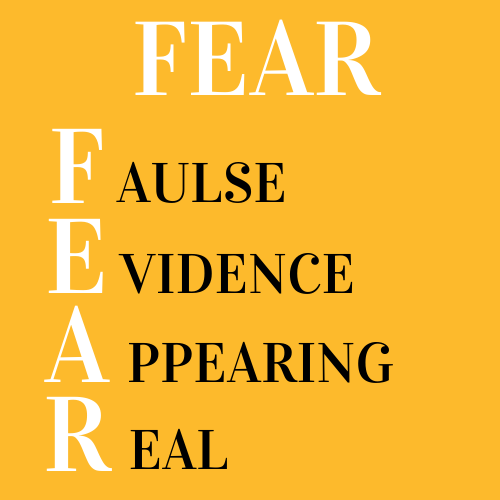Overcoming fear starts with understanding that fear is a primitive emotion that creates a mostly automatic alarm system in our body to warn against threats to survival.
Fear is a feeling. Feelings are physical responses in the body. This feeling comes from our thoughts.

Millenia ago, when our brains were first evolving fear existed as a fear of bodily harm and death, these days fear exists in the fear of failure, of displeasing others, of letting others or our self, down, of rejection, of being alone.
We may not be aware of it but fear most likely dictates our responses and reactions to many of our daily interactions and decision making. Many of us harbor fearful thoughts without being aware. These thoughts can come in many forms; limiting beliefs about our worth and our abilities, ideas of scarcity and lack, thoughts of anxiety and a need to control.
These thoughts really are about wanting to protect ourselves, not from a lion on the savanna like our ancestors faced, but from feeling negative emotions. For example, thinking a fearful thought such as
“What if I fail?”
is your brain’s way of protecting you from feeling shame if you don’t succeed.
My Personal Fear Journey
It’s funny because I set out to write a blog post about fear and I found myself unable to write it. I struggled for weeks on the topic. I ended up doing a lot of coaching and thought work around fear: Is it because I am afraid? Am I afraid of failure? Of it not being perfect? Maybe it is that I don’t know what I really want to say? Or that I don’t think I know enough to have something valuable to say.
To get myself over this block I started researching the scientific basis for fear. This research helped me to understand that it is not just me, our brains are trying to keep us safe at all cost. I had written about this previously: how your brain will never want to do something uncomfortable or new and how this can harm your motivation and willpower .
What I realized was the same is true for situations your brain perceives as a threat, or that will result in you feeling negative thoughts. This can be soooo many different things depending on the person.
For some people their brain perceives the biggest threat as feeling a negative thought such as shame, rejection, regret. For others our brain may perceive the greatest threat as a threat to our ego and self-worth, for others it may be the fear of not belonging, or the fear of scarcity.
First let’s dive in to the science, then we will talk about how to overcome the fears
What is fear?-our brains way of protecting us
Your brain is hardwired for survival, blame it on 200,000 years plus of evolution. Our brain wants to keep us alive and fear is a critical component of survival. Fear is a primitive emotion that involves the amygdala, the hippocampus and the prefrontal cortex which work together to create a mostly automatic alarm system in our body to warn against threats to survival. This primitive, automatic response to fear is often referred to as the ‘fight or flight’ response. Some of the main chemicals that contribute to the “fight or flight” response are also involved in positive emotional states, such as happiness and excitement. This is why some people love to jump out of airplanes.
The lizard brain- the automatic response
The fear response starts in a region of the brain called the amygdala located in the temporal lobe of the brain. This portion of the brain is responsible for recognition. For example, the amygdala activates whenever we see a human face with an emotion (this is especially true with anger and fear). When in fear, a threat stimulus triggers a fear response in the amygdala, which activates areas responsible for motor functions such as ‘fight or flight’ responses as well as releasing stress hormones.
This results in the body responding to danger by becoming hyperalert: pupils dilate, the bronchi dilate, breathing accelerates, heart rate and blood pressure rise, blood flow and a stream of glucose to the skeletal muscles increase, and organs not vital in survival such as the gastrointestinal system slow down.
The analytical brain -the higher-level response
The analytical response to fear is controlled by the hippocampus which is closely connected with the amygdala. The hippocampus and prefrontal cortex help the brain interpret the perceived threat. The prefrontal cortex, a section of your brain located right behind your forehead, is responsible for decision making, self-control, willpower and regulating behavior. These two parts of the brain are involved in a higher-level processing of context, which helps a person know whether a perceived threat is real.
That perception of whether a threat is real depends on whether we feel we are in control. Control is vital to how we experience and respond to fear. When we overcome the initial ‘fight or flight’ rush, we are often left feeling satisfied, reassured of our safety and more confident in our ability to confront the things that initially scared us.
What this means to you: fear is an automatic response that your brain creates based on the thoughts that you feed it. Change your thoughts and you can stop letting your brain think you are in fear.

How to notice if you are in fear:
Now that we have covered the scientific basis for fear, let us explore how this can apply to our lived experience in the 21st century not on the plains of Africa millennia ago.
The five types of fear:
Now a days we are not faced with threats to our body and our survival like our distant ancestors were. Now fear exists in the fear of failure, of displeasing others, of letting others or our self, down, of rejection, of being alone. We may not be aware of it but fear most likely dictates our responses and reactions to many of our daily interactions and decision making.
According to author Karl Albrecht, all fears, regardless of how big or small, fall into five categories: fear of extinction and fear of mutilation, fear of losing autonomy, fear of separation, and fear of ego-death. Consequently, the role of fear is to promote survival in these five domains.
- Fear or extinction and fear of mutilation or biological survival and physical health are self-explanatory. We want to and need to be healthy and to survive.
- Fear of losing autonomy can be explained as the need to make our own decisions, and live our lives the way we choose. We do not want to be restrained, either in a relationship, job, or in a small space.
- Fear of separation is considered social survival. We want to and need to belong and be accepted and respected by our peers. We avoid criticism and judgment. We fear rejection, being alone, irrelevance, and being unwanted.
- Fear of ego-death is the fear of our own self-worth. The fear of feeling worthless and inadequate can be very limiting, because you will restrain yourself from expressing yourself and putting yourself out there. This is why being rejected by a partner or fired from a job can be so devastating.
Four responses to fear
We generally have four responses to fear: freeze, fight, flight, or fright. These categories seem self explanatory when faced with a bodily threat: a lion, a murderer, a tornado… but what about the ways we respond when our brain perceives the threat of feeling a negative thought such as shame, rejection, regret, or when our brain senses a threat to our ego and self-worth?
- Freeze: You stop what you are doing and focus on the fearful stimulus to decide what to do next. This can result in an inability to respond. You may stay silent, and not defend yourself. You may remain speechless. This can result in taking verbal abuse and mis-information about yourself for fear of speaking up, fear of rejection etc. An example might be when a boss misinterprets something you have done and you do not correct them out of fear.
- Fight: You deal with the threat directly. This response can often lead to acting defensive and lashing out. You may wish to inflict mental and verbal harm on others, you may become angry and or persistent until you get your way.
- Flight: You will seek a way to flee or work around the threat. You may chose avoidance through not thinking about or facing the ‘threat’ through numbing or through actual removal from the situation (think just quitting the job or the relationship or school…)
- Fright: When the fear is so overwhelming you neither fight nor flee, you take no action. This response can manifest in decision paralysis. You may be so afraid to act that you do nothing and years later look back and wish you had gone for it.
How to change your fear response-
The important thing to take away from all of this sciencey stuff is that fear is in your mind.
It is only a feeling. It is made up. It is in the future. I hasn’t even happened yet.

Try any of these tactics:
- Sit with your fear for a minute and ask what are the thoughts that are causing this feeling of fear?
- Flip it around – Tell yourself that it is information and you can learn from it.
- Tell yourself the sensation you are feeling is excitement not fear-(this is a Mel Robins trick that she uses for many things but especially to overcome her fear of flying)
- Identify if your thoughts come from a place of scarcity (you can use this worksheet to identify and change your thoughts)
- Identify if your fear is manifesting as limiting beliefs (use this worksheet to identify and change these beliefs)
- A fun and different approach (from Elizabeth Gilbert, Big Magic) Write a letter from fear: what are you actually afraid of? Now write a letter to fear: acknowledge it, thank it, and explain your new plan.
Remember that fear is all about how you chose to look at things. It is your brains way of protecting you. If you can tell your brain that the threat is not REAL than you can move past your fear.
A final thought: What are you afraid of? What is holding you back? Remember that fear is only a feeling and you create those feelings. Move towards the fear and with time your confidence will grow!

References
https://www.smithsonianmag.com/science-nature/what-happens-brain-feel-fear-180966992/



Your article gave me a lot of inspiration, I hope you can explain your point of view in more detail, because I have some doubts, thank you.